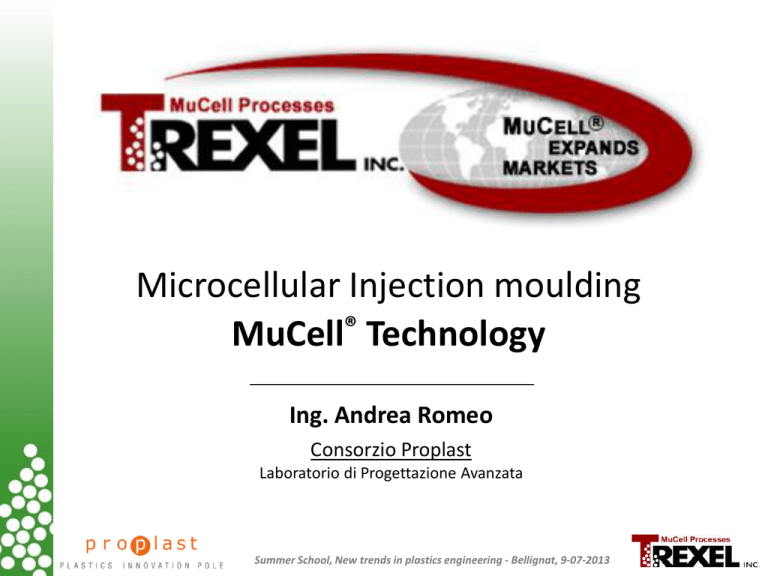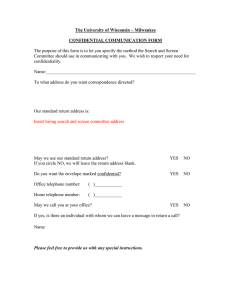Microcellular Injection moulding MuCell® Technology
advertisement

Microcellular Injection moulding MuCell® Technology Ing. Andrea Romeo Consorzio Proplast Laboratorio di Progettazione Avanzata Summer School, New trends in plastics engineering - Bellignat, 9-07-2013 The MuCell®-Process-Technology 1. MuCell Basics and Function 2. Strategic Advantages 3. MuCell Design Rules 4. General MuCell Examples MuCell® Basics and Function Function and technical equipment Two Main Characteristics describe the MuCell® Process 1. Lowering of the viscosity of thermoplastic resins by controlled feeding of gas (either N2 or CO2) into the melt 2. Creation of a microcellular Structure in the part core by gas expansion in the cavity (Injection Moulding) or after the die (Extrusion) The MuCell® Process Creating a single phase solution – injecting the SCF (super critical fluid) into the thermoplastic melt during screw recovering Creating a single phase solution Injecting SCF The MuCell® Process Dissolving SCF into the melt Screw flights break-up SCF stream Mixing flights cause SCF to divide into smaller bubbles and then dissolve Inject SCF + Diffusion Complete SCF Polymer The MuCell® Process Foaming occurs during injection into the mold . . . . .. . . . . .. . . . . . . . . . . . . Time . . . . . Time Low pressure in the mold cause SCF to form cells Cells grow until the material freezes or the mold cavity is full MuCell® Moulding Technology Scanning Electron Microscope (SEM) microstructure Source: Material: Nylon 66 with 35% glass fibers MuCell® Moulding Technology Compact skin – Foamed core – Compact skin MuCell® Moulding Technology Control of Foaming Controlling cell size and the number of cells – Correct SCF level: Higher SCF creates more cells (Always a limit to how much SCF) – Rate of pressure drop (controlled primarily by injection speed) Trexel Confidential 10 MuCell® Strategic Advantages MuCell Design Rules Limitations of Solid Molding Influence on part quality Saving potentials MuCell Design Rules Limitations of Solid Molding Solid molding is constrained by: Need to push plastic from gate to end of fill without freezing off Need to pack the part along the entire flow length… To obtain uniform shrinkage for dimensional stability To eliminate sink marks and vacuum voids These processing limitations impose design restrictions that affect the ability to reduce wall thickness The MuCell Process removes these restrictions! MuCell versus Solid Molding • Reduced viscosity (10% to 15% for a 30% glass fiber) – Increased flow length – Lower fill pressures • Cell growth replaces the pack/hold phase, resulting in lower and more uniform cavity pressure – Pack pressure does not need to go from gate to end of flow • Pack takes place locally – – – – Lower pack and hold pressures Shorter pack and hold times Reduced cavity pressures Lower clamp forces • Less molded-in stress = Reduced warpage • Reduced cooling required Trexel Confidential 15 Strategic Benefit Capacity Use (Reduced cycle time) Opening/Eject./ Injection Closing Pack&Hold Cooling Solid Δ T MuCell® ΔT depends on material type, part design and mould cooling Hold time (nearly) eliminated Reduced cooling time More exchange Less temperature Delete parameter hold The parameters hold pressure pH and hold time tH are deleted by the MuCell® Foaming Process. Part formation by cell growth, independently of part weight Counteraction against shrinkage not by additional packed mass Equal pressure distribution in the cavity (significant less difference in pressure levels near injection point and far injection point) Example: Connector Housing with PBT GF 30 Decoupling of part dimensions and part weight Trexel Confidential Strategic Benefit Machine Size (reduction of hydraulic pressure) MuCell® Solid Peak pc = 1045 bar Peak pc = 448 bar Screw position Data Com Connector, PBT with 30 % glass 57 % reduction in peak cavity pressure Due to viscosity reduction, less resin volume, no pack & hold pressure Longer tool life Trexel Confidential 18 Microcellular Foam Properties Without foam 10% physical foam DSC - Curve: PBT GF 30 with mould temp. 80°C Source: Ticona DSC - Curve: PBT GF30 with mould temp. 30°C Source: Ticona Melting temperature : 225,4°C Heat of Fusion (H): 40,67 J/g Melting temperature: 225,0°C Heat of Fusion (H): 41,93 J/g Crystallinity Level is identical Trexel Confidential 19 Strategic Benefit Quality (faster product release) 95.9 200 Gate 1 Width- Open side Overall Width- Rectangular Box 96,200 96,100 96,000 95,900 95,800 95,700 95,600 95,500 1 2 3 Cav1- Solid 4 2 3 Position (Gate at # 4) Cav1- MuCell 4 Cav2- Solid 5 Cav2MuCell 5 More consistent & predictable MuCell® dimensions simplify mould design & reduce the number of costly iterations Trexel Confidential 20 Maximizing MuCell Advantages • Phase I: existing mold - Learning and Validation – Current designs at Pre-production stage or earlier – Establish comparisons with solid parts • Phase II: Using New Design Rules – Design for MuCell with thinner walls, wall thickness variations, and different rib structures Trexel Confidential MuCell® design rules Designing for function Differences in Wall Thicknesses Shrinkage Mechanical properties Designing for MuCell • If parts are designed for the MuCell Process at the outset, parts weight can be reduced >20 % Trexel Confidential MuCell Vs Solid Molding • Foam expands more into thick sections less in thin sections – Foam expands until the flow front freezes • Freeze happens more quickly in thin sections – Necessary to push the plastic further into thin sections to have complete fill – Gate into thin sections, flow into thick sections • Expansion will eliminate sink marks Trexel Confidential 27 Differences in Wall Thicknesses Filling from “thin to thick“ Recommended injection with MuCell® Injection in solid (with MuCell® still possible) Wall to rib ratio 1:1 possible MuCell® design Conventional design Trexel Confidential 28 Shrinkage in [mm] 599 599 600 599 599 599 598 599 Solid dimensions MuCell dimensions Shrinkage is a little bit higher but much more uniform (in flow and in X-flow direction) Mechanical Properties Influence for mechanical properties of gate location on test specimens and on real parts Specimens Mould: End of flow 3D Part Mould: Thickness = 4 mm Strength on test specimens Thickness = 2 mm End of flow Injection point Near the gate Designing for Function Example: 15% weight reduction through wall thickness optimization and 4 % with density reduction 1.11 mm at tip of ribs 1.75 mm at top of front wall 1.55 mm at base of front wall 1.31 mm 1.22 mm 1.49 mm at base 1.12 mm 1.12 mm Gate Location Trexel Confidential 1.2 mm 36 Part Design – Wall Thickness • Weight reduction is highly dependent on flow factor - Ratio of Flow Length to Part Thickness • Weight reduction also dependent on - Part Thickness - Material - Gate Location 40 Weight reduction [%] 35 % Wt. Reduction envelop as a function of flow factor Low viscous (PA) top High viscous (PC gf30 fr) low 30 25 20 15 10 5 0 50 75 100 125 150 175 200 Flow Factor Trexel Confidential 37 225 250 General MuCell® examples Glass fibers and flatness Appearance Applications Performance measurement of flatness 3.2 mm test plaques Less warpage more uniform mechanical performance PP 40 % LGF Solid PP 40 % LGF Solid PP 40 % LGF MuCell PP 40 % LGF MuCell Trexel Confidential 39 MuCell® Appearance Applications Modified materials (PA 6, PA 6/6 & PBT) Mould based solutions Appearance parts in mass production with IMD Technology Trexel Confidential 40 MuCell® Applications Automotive OfficeEquipment Industry & Electric/ Electronic Semi conductors Packaging Trexel Confidential 41 Packaging – Super Light Injection Molding MuCell® Benefits: • Reduce clamp tonnage (smaller machines) 4+4 cavities on 350 t instead of 500 t Higher cavitation • Reduced injection pressure Design reduced wall thickness, -15 % Improved performance with IML Technology Use thinner labels (lower material viscosity) • Weight reduction = 5,5 % Trexel Confidential 42 Circular Saw (Base Plate) Replacement of aluminium die-cast part by MuCell base plate of PA 6.6 GF55 Wire Harness Key MuCell Objectives: • Dimensional stability • Flatness of parts and ease of assembly Key MuCell Results: • Weight reduction = 8 % • Cycle time reduction = 10 % • Dramatically improved dimensional stability and warpage reduction 44 MuCell® Electronic Housing MuCell® Benefits Smaller injection moulding machine Shorter cycle time Improved flatness, reduced warpage, accurately fitting Improved breaking behaviour at destructive testing MuCell® Car Key MuCell® Benefits • Equal shrinkage with different wall thicknesses on the part (reduced warpage) • Elimination of sink marks • Achieve „Class-A“ surface for application of high gloss scratch resistant clear lacquer Valeo - Interior Bezel General Motors - Opel Corsa Quality Improvement 2002 SPE Automotive Innovation Award Winner • Eliminated sink marks Category: Process / Enabling Technologies • Improved dimensional stability Process Improvement • Clamping force reduced from 250-tons to 75-tons • 10% Weight savings Cycolac CRT 3370 ABS - glass filled •Not necessary to preform the IM label (label is thinner, because of less wash-out effect) MuCell is generally targeted to non-aesthetic parts unless the part is covered, in-mold decorated, in-mold labeled or painted Trexel Confidential 47 MuCell® Torso Airbag Cover Key MuCell® Objectives: • Elimination of different shrink (elimination of “sink marks” caused by different cross sections) • Design freedom • Painted Key MuCell® Results: • No deviation in shape (no “sink marks”) • Improved dimensional stability • Improved function of the living hinge • Smaller machine requirement (300 t instead of 500 t in solid) • Successful painting Trexel Confidential 48 MuCell HVAC Systems Key MuCell Objectives •Avoidance of warpage •Machine size reduction •Weight savings Key MuCell Results •9-12% weight reduction •Machine size reduction from 1000 tons to 600 tons •Cycle times savings of 10-15% •Improved product assembly •Fewer mold corrections 20% Talc Filled PP 49 MuCell Fan Shrouds Key MuCell Objectives •Cycle time savings •Machine size reduction •Weight savings •Warpage reduction Key MuCell Results •Typical weight reduction 7-10% •Machine size reduction from 1000 tons to 500 tons •Cycle time savings of 25-40% •200% improvement in fatigue resistance Typical materials: PA 66 GF 30 PP GF 30 PA 6 G+M 43 Chrysler 50 RS Dual fan shroud MuCell® Cam cover MuCell® advantages 30 % reduced machine size (350 instead of 500 t for conventional molding) Improved cycle times, which allow for simultaneous production and assembly process Lighter part Improved flatness Trexel Confidential 51 MuCell® Sun Roof Frame MuCell® Benefits Reduced amount of components, tools and assembling processes Dramatically reduced warpage in spite of a complex geometry Only one optimization loop required after tool construction (shorter project time) Daimler W212 Door Trim Winner 2009 in category Interiors MuCell® parts (abs): Carrier: Thinner wall thickness by lower viscosity 10 % density reduction by MuCell Tandem-Mould Technology plus MuCell (with > 50 % cycle time red.) Wall thickness to rib ratio = 1:1 Map Case: Wall thickness to rib ratio = 1:1 Deletion of one tool and an additional assembling process (by MuCell Design) Advantages with IML Technology (lower pressure levels) Conclusion MuCell process allows significant savings Very short Pay back Valuable benefits: •Weight reduction -Due to the microcellular expansion, -Via pre-design/optimization of the part (wall thickness reduction) usually 8-10% up to 35% up to 50% 40 to 60% up to 60% •Cycle time reduction •Injection pressure reduction •Machine size reduction •Warpage/deformation reduction •Avoidance of sink marks •Uniform directional dimensional shrinkage •Time to market reduction (fewer mould modifications to dimensional conformity) •Lower energy consumption/Environmental impact PROPLAST, Trexel, ENGEL partnership To promote and disseminate the Mucell technology Demo installation At Proplast’s site (Tortona, Italy) IMM: Engel 180 tons, screw: 55 mm Shot weight: 100-500 g Mucell unit - Co2 or Nitrogen Goals Support customers at every stage of the technology implementationa and application •Part design for Mucell (optimization, moldflow Mucell simulation etc) •Support to mould design •Mucell moulding trials / mould piloting R&D projects ongoing Aestethical aspect optimization (class A surface, material design and optimization) Combination with H&C technologies (pressurised water, induction) Thank you for your attention Ing. Andrea Romeo Consorzio Proplast Advanced Design Lab andrea.romeo@proplast.it +39 01311859743 www.proplast.it Summer School, New trends in plastics engineering - Bellignat, 9-07-2013
